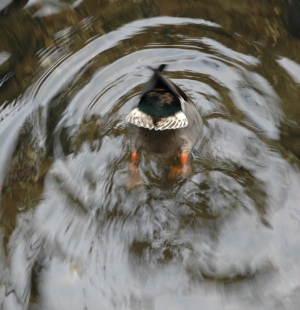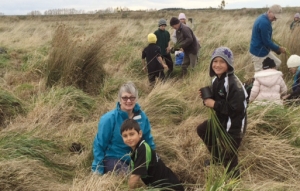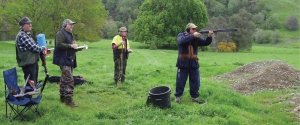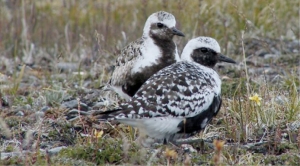Super User
Mallards in focus – and still under threat
There is an erratum that is worth mentioning – in regards to the shallow ponds being most used by broods. The shallow ponds are all less than 43cm deep. This is the depth that is recognised in literature as the maximum depth adult mallards can reach when tipping up to feed (Phillips 1923 & Olney 1960 in Perret 1962).
Additionally, staff have now completed sifting through the 250,000+ photos from our ‘Operation Duck Pond’ study. As anticipated, ponds in Southland that were used most often by broods had the following attributes:
- A greater area of shallow feeding zone, defined as pond depth being less than 43cm (the accepted maximum depth an adult duck will feed on the bottom). The majority of the top producing ponds were in fact, 100 percent shallow feeding zone. This resulted in many photos of feeding ducks, “heads down, bums up!”
- A higher availability of food items present (such as macroinvertebrates: waterboatmen, freshwater snails, etc). Obviously, there are many factors that affect the presence and abundance of these food items in a pond.
- A suitable level of shelter particularly from the south and west pond edges, and overhead cover present along the western edge.
- A fence to keep stock off the pond periphery so that vegetated edges were not grazed by livestock. Whether this is a relationship with stock disturbance, or degree of vegetation, we do not know.
- Creating shallow (or seasonal) ponds and wetlands that are protected from the elements will be a broods favourite retreat. These factors, coupled with successful predator control should see more ducklings (and mothers) survive the breeding season. However, that leads us to our next study.
This upcoming mallard breeding season the game cameras will be placed throughout the landscape aiming to capture images of mallard nest predators, namely stoats, ferrets and feral cats. This will be combined with a heavy trapping regime and monitoring of nests within a marked study area. We look forward to reporting on our results!
Perret, N.G. 1962. The spring and summer foods of the common mallard (Anas platyrhynchos platyrhynchos L.) in south central Manitoba. Unpubl. MSc Thesis, University of British Columbia, Vancouver.
And -Yeh – looks like the same cat, obviously included the pond in its circuit – have a dozen photos where you can just see the ears and head in the grass, where it obviously just sat and watched for ages! (Camera was set on time lapse, taking photos every 5 minutes).
Erin Garrick
DUNZ member honoured for conservation work
Conservation rates highly with DUNZ members, so it’s not surprising that one of our own received an award for commitment to the cause in this year’s Queen’s Birthday Honours list.
Andrew (Andy) Graeme Lowe, of Havelock North, a long-time member of Ducks Unlimited, was made a member of the New Zealand Order of Merit (MNZM) for services to conservation.
Andy is the managing director of Lowe Corporation in Hawke’s Bay and has been the initiator and vision-keeper for Te Matau a Maui, the Cape Kidnappers Sanctuary, which is the largest privately funded mainland wildlife reserve in New Zealand.
In 2006, Andy and other land owners began an ambitious project to restore the Cape Kidnappers peninsula back to its former wildlife glory. Covering 2500 hectares, the sanctuary has the most diverse range of native bird life on coastal mainland New Zealand.
Cape Sanctuary is owned by Julian Robertson and the Hansen and Lowe families who share the vision to restore the coastal community of land birds, sea birds, reptiles and invertebrates that once flourished there.
The project aims to achieve significant biodiversity gains alongside existing land uses of farming, forestry, recreation and tourism. The sanctuary includes a DOC reserve of 13ha.
There is also the Cape to City venture, a wide-scale predator control and ecological restoration project over 26,000ha of land between Hastings and Cape Kidnappers, extending south to include Waimarama and forest remnants at Kahuranaki. This is a sister venture to the successful Poutiri Ao o Tane ecological restoration project in the Maugaharuru ranges, near Tutira.
The Cape Sanctuary project is also part of Cape to City and is a partnership between the Hawke’s Bay Regional Council, DOC, Manaaki Whenua – Landcare Research and various landowners and businesses, and has funding from the Aotearoa Foundation.
Andy is also involved with the Martins Bay restoration at the end of the Hollyford Valley in Fiordland National Park. Known as a “biodiversity hotspot”, the area has unparalleled marine and terrestrial landscapes, habitats, flora and fauna, ranging from fragile dune systems and wetlands to unique prodocarp forest, and is the only place in the country where bottlenose dolphins enter a fresh water lake.
Wairio wetland plant day – another success
June 21 work started at 9am for the organisers, supported by some strong lads from Taratahi Agricultural Training College and farm workers from a local sheep and beef station Palliser Ridge. Those strong farming trainees dug holes in pre-sprayed spots in rough, fescue infested terrain.
Just after 10am we also had about 20 school children from Martinborough and Kahutara primary schools arrive to “assist” in planting flaxes in the holes prepared by the aforementioned lads and workers. In all, around 65 folk helped with the planting and by 12 noon, 750 plants (about half of them kahikatea) were in the ground at the noreastern corner of the Wetland.
Greater Wellington Regional Council provided educational support and the school children, in addition to planting, were treated to a field class identifying plants common to the Wetland. That and the hot sausages for lunch (again provided by GWRC) made a great day for the children who said they would be back next year to see how “their” plants were growing.
Jim Law.
Restoration Day – Success
Restoration Day at Wario May 21, proved to be a success with helpers like Ross Cottle, Ian Gunn, and Tapuwa Marapara, who were able to share their expertise with those who attended.
Adding to the success was the wide diversity of people present, both as presenters and as participants. There were 30 on the bus all up and the combination of talks on the bus and pauses during the field trips gave plenty of time for the story to unfold and for people to ask questions.
The weather played its part too!
It’s all science: Two PhD students, Eve Sutter (wearing hat) and Elisa Piispa, from Victoria University School of Chemistry and Physical Sciences, using an array of electrodes to measure below-ground resistivity at various depths. The technique can be used to estimate the profile of the water table along a transect without the need to dig multiple bore holes.
Stephen Hartley
(Stephen was the organiser).
There is a long, long trail a winding…
From the President
I am sitting here at the computer looking out the window towards Lake Whatuma watching the rain continue to fall. We have had 30mm over the last 12 hours with more to come!! A real blessing as we in Hawke’s Bay, like many other regions, have experienced one of the driest autumns over the last 100 years. Climate change means we will be faced with increasingly less rainfall and warmer air temperatures. Wetlands need water to function and as one of our prime goals is to enhance and create wetlands our task is not getting any easier. We need to continue with this important work and encourage others to do likewise.
The annual DU conference at Taupo was a real success and it is always great to catch up with like minded people. For many of us it is the only time that we do meet and some of these friendships go back decades.
John Cheyne
Keeping their eye in
A DU shoot was held at James and Di Martins place at Waitawa just north of Martinborough on October 9.
There were 50 shooters, so plenty of competition. Paul Hullet top scored with 84 out of 100.
Weather was overcast with the odd light showers, but a great day.
Ruffit Lodge opening day
Amazing how keen some folk are to get out there on opening day, rain or shine, they have the kit ready to go and hope to catch something in their sights….
An inter-generational hunt on Opening Day, with 11 hunters, plenty of camo, (and ammo presumably) and lots of enthusiasm, but no ducks.
But out at Ruffit Lodge on that day as a group trudged through the undergrowth to reach the optimum positions, other exciting things were taking place.
Up to 22 ducklings had huddled together, if that was wise or not, I do not know, but Julie Candy certainly took a few photos of those little fluffy birds. Julie said there were actually two clutches of duckling, with 22 in one clutch.
And then there was the case of the lost frog. How it ended up on Neil Candy’s thumb I am not sure, but he recognised it as a tree frog – imported of course.
After a couple of emails to a helpful boffin at Victoria Uni, we had an actual scientific name. The frog is an introduced Australian brown tree frog (or whistling frog) Litoria ewingii. Now how is that for name!
UNESCO protecting a world heritage site
On July 17 this year, the Marshlands of Southern Iraq, often referred to as the ‘Garden of Eden’, were named a UNESCO World Heritage Site.
The Mesopotamian Marshlands in the lower floodplains of the Euphrates and the Tigris are the largest wetland in the Middle East. The source of the water is upstream in the mountains of Turkey, Iraq and Iran.
The Ahwar of Southern Iraq, as the marshlands were known, are home to hundreds of thousands of birds and at least 40 fish species. The marshes are a stopover point for many birds as they migrate from Central Asia to Africa. These wetlands also play a part in preventing dust storms, which are extremely detrimental to the economy, living conditions and health. They also moderate the temperature in this very hot part of the world. Throughout millennia the area has supported various peoples and their livelihoods, including ancient cultures such as the Sumerians. The World Heritage site unites these natural and cultural aspects.
Wetlands International welcomed the decision to inscribe the marshes on the UNESCO World Heritage List. However, the marshlands face serious constraints to maintain and strengthen the intrinsic values they were inscribed for. The marshes have only partly recovered from severe damage by past drainage and warfare. By 2000, 90 percent of the marshes had been destroyed due to large scale drainage during the Saddam Hussein regime. After the fall of the regime around 40-60 percent of the marshes were re-flooded.
The partially recovered wetlands and the people who depend on them are under threat again from developments such as large dams and agricultural schemes further upstream, which significantly reduce the amount of water flowing to the marshes. Solutions need to be found so the precious river water available is used wisely for the marshes, drinking water and agriculture, and that the oil industry does not compete for water nor pollute the area.
The marshes’ World Heritage status is an important incentive for increased (international) support for the protection of these marshes, including the resources they provide to local people. We hope this nomination will lead to better water management, increased knowledge of its biodiversity values and a sustainable integration of the conservation of the marshlands with social and economic development.
We have been working in this region for many years and were involved in preparing the nomination of the site for World Heritage status. Over the coming years we hope to continue our work to help restore and conserve this iconic wetland and reduce potential impacts from the oil and gas industry.
Plovers go to Russia for love
Two small migratory shorebirds - Grey Plovers from the Adelaide International Bird Sanctuary - made it once again all the way to the remote Wrangel Island off the coast of Russia near the Arctic Circle.
On their annual migration to breed the birds fly over 13000kms from Thompson Beach, north of Adelaide, including an incredible 7000km non-stop stretch from Adelaide to China.
“Who would have thought that a bird at Thompson Beach would, just a few months later, be roosting among polar bears and musk ox?” said Natural Resources Adelaide and Mt Lofty Ranges Manager of Coast and Marine, Tony Flaherty.
Mr Flaherty said the plovers were tagged with tiny solar-powered satellite trackers, to discover what parts of the Adelaide International Bird Sanctuary and Gulf St Vincent they use. Researchers also wanted to learn where they go and stop along their epic journey to the Arctic breeding grounds.
“Little was known about the migratory route of the plover, and knowing where these birds go really helps with conservation efforts to protect shorebirds,” Mr Flaherty said.
The tagged plovers left in March to fly along the East Asian-Australasian Flyway, taking distinctive routes to the northern hemisphere.
Mr Flaherty said uncovering this Grey Plover migration route can also help with international efforts to conserve their stop-over sites in Plover pair: Distinctive and tough birds. China and nesting sites in the Arctic.
“Disturbance and impacts to coasts across the birds’ migratory route all add up. What we do on our local beaches can also help these birds prepare for these incredible journeys.”
Researchers were also surprised at how little the birds moved from Thompson Beach during the Australian Summer. Here they spent their time feeding on the rich tidal flats and roosting on the beaches and nearby salt marsh and lagoons.
During the warmer months, the Adelaide International Bird Sanctuary, located north of Adelaide, is home to approximately 27000 resident and migratory shorebirds. The area provides a safe haven for the shorebirds and a smorgasbord for feasting.
The research has been carried out by a partnership between Friends of Shorebirds SE, the Victorian Wader Study Group and the South Australian Department of Environment, Water, and Natural Resources, with funding support from the Adelaide and Mt Lofty Ranges Natural Resources Management Board Shorebird Project and the Australian Government-funded Samphire Coast Icon Project.





